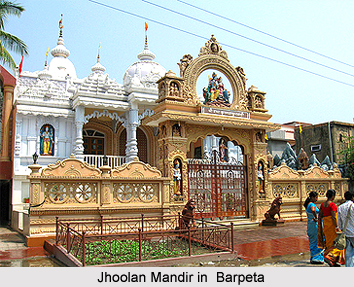 History of Barpeta District narrates the tale of Koch King Naranarayan who founded Barnagar (Sorbhog) The Barpeta District formed an essential part of the Koch-Hajo and the Ahom Kingdom till British Administration took over. Barpeta district witnessed the rule of several dynasties like the Varman Dynasty in Assam, the Salasthamas, the Pala Dynasty, the Kamatas and the Koches. Barpeta is also known as Tatikuchi, Porabhita, Mathura, Vrindavan, Choukhutisthan, Nabaratna-Sabha, Icchakuchi, Pushpak Vimana and Kampur.
History of Barpeta District narrates the tale of Koch King Naranarayan who founded Barnagar (Sorbhog) The Barpeta District formed an essential part of the Koch-Hajo and the Ahom Kingdom till British Administration took over. Barpeta district witnessed the rule of several dynasties like the Varman Dynasty in Assam, the Salasthamas, the Pala Dynasty, the Kamatas and the Koches. Barpeta is also known as Tatikuchi, Porabhita, Mathura, Vrindavan, Choukhutisthan, Nabaratna-Sabha, Icchakuchi, Pushpak Vimana and Kampur.
Major historical developments in the Barpeta district took place during the Kamata and Koch rule. During this period, large number of local feudatory-chiefs who are primarily land-lords called `Bhuyans` ruled the region. A number of villages constituted a `Chakla` placed under a Bhuyan was patronised by the Kamatas. These Bhuyans arrived from eastern part of India like Kanauj, Gauda and Bengal. With the passage of time, they became general Assamese caste and accepted the Vaishnavism faith under the influence of Shrimanta Sankardeva. Koch King Naranarayan established his temporary capital at Barnagar. Here he met Shrimanta Sankardeva and his renowned disciple and subsequently accepted Vaishnavism when Sankardeva was invited by the monarch to Koch Bihar district in West Bengal.
It was during King Naranarayan`s regime at Barnagar the great saint established Satra at Patbaushi to spread his socio-religious faith. The Koch rule ended with annexation by the Mughals. The courageous Ahom fought a number of battles against the invading Mughals. Some of the well-known battles were fought at Jakhlikhana, Bhabanipur and Bhatekuchi. Ahoms were defeated and Mughals took over the administration and systematised the entire revenue administration. Kamrupa became a Sarkar, which was divided into Parganas. A "Gomasta" was appointed to run the `Tapa` and a number of `Tapas` became a Pargana. For administrative convenience the Parganas were divided into Taluks, lats and villages. Parganas were placed under Barbaruas and Choudhuries. Taluks remained under Talukdar. They were assisted by Thakurias, Patwaries, Kakati, etc. who kept the revenue accounts. Judges in Parganas were called Shikdar, whereas Amin and Kanango were responsible for land-survey, assessment and collection of revenue.
With the advent of Shrimanta Sankardeva, this region turned into a religious place dotted with numerous satras. Further, Barpeta town came to be called `Boikumthapuri Dham. As a part of providing patronage to various religious-places irrespective of religions, the Ahom rulers provided a large number of land grants to the Satras. Widespread destruction of life and property took place when the Maans invaded from Myanmar. Even the Barpeta Satra was demolished during this invasion. To restore peace, British army entered Barpeta to drove-off all the invaders. With the advent of British rule, Mouzadari system came into effect. As a part of policy of exploitation, land-revenue rates were suddenly enhanced. The Lachima uprising is one such example of peasant revolt against the British rule. Raijor Sabha constituted during this period raised the banner of revolt. During the struggle for independence, large numbers of people participated and were imprisoned. Mohan Chandra Barman and Rauta Koch were first martyrs to sacrifice their lives during Quit India Movement of 1942.
Barpeta District in Assam was carved out of erstwhile Kamrup District of the state in the year 1983. In 1841 Barpeta District became a Civil Sub-Division and John Batlor became the first administrator.






